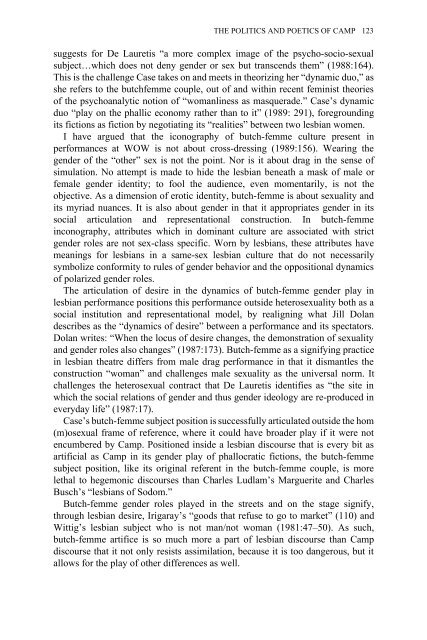Edited by Moe Meyer - Get a Free Blog
Edited by Moe Meyer - Get a Free Blog
Edited by Moe Meyer - Get a Free Blog
You also want an ePaper? Increase the reach of your titles
YUMPU automatically turns print PDFs into web optimized ePapers that Google loves.
THE POLITICS AND POETICS OF CAMP 123<br />
suggests for De Lauretis “a more complex image of the psycho-socio-sexual<br />
subject…which does not deny gender or sex but transcends them” (1988:164).<br />
This is the challenge Case takes on and meets in theorizing her “dynamic duo,” as<br />
she refers to the butchfemme couple, out of and within recent feminist theories<br />
of the psychoanalytic notion of “womanliness as masquerade.” Case’s dynamic<br />
duo “play on the phallic economy rather than to it” (1989: 291), foregrounding<br />
its fictions as fiction <strong>by</strong> negotiating its “realities” between two lesbian women.<br />
I have argued that the iconography of butch-femme culture present in<br />
performances at WOW is not about cross-dressing (1989:156). Wearing the<br />
gender of the “other” sex is not the point. Nor is it about drag in the sense of<br />
simulation. No attempt is made to hide the lesbian beneath a mask of male or<br />
female gender identity; to fool the audience, even momentarily, is not the<br />
objective. As a dimension of erotic identity, butch-femme is about sexuality and<br />
its myriad nuances. It is also about gender in that it appropriates gender in its<br />
social articulation and representational construction. In butch-femme<br />
inconography, attributes which in dominant culture are associated with strict<br />
gender roles are not sex-class specific. Worn <strong>by</strong> lesbians, these attributes have<br />
meanings for lesbians in a same-sex lesbian culture that do not necessarily<br />
symbolize conformity to rules of gender behavior and the oppositional dynamics<br />
of polarized gender roles.<br />
The articulation of desire in the dynamics of butch-femme gender play in<br />
lesbian performance positions this performance outside heterosexuality both as a<br />
social institution and representational model, <strong>by</strong> realigning what Jill Dolan<br />
describes as the “dynamics of desire” between a performance and its spectators.<br />
Dolan writes: “When the locus of desire changes, the demonstration of sexuality<br />
and gender roles also changes” (1987:173). Butch-femme as a signifying practice<br />
in lesbian theatre differs from male drag performance in that it dismantles the<br />
construction “woman” and challenges male sexuality as the universal norm. It<br />
challenges the heterosexual contract that De Lauretis identifies as “the site in<br />
which the social relations of gender and thus gender ideology are re-produced in<br />
everyday life” (1987:17).<br />
Case’s butch-femme subject position is successfully articulated outside the hom<br />
(m)osexual frame of reference, where it could have broader play if it were not<br />
encumbered <strong>by</strong> Camp. Positioned inside a lesbian discourse that is every bit as<br />
artificial as Camp in its gender play of phallocratic fictions, the butch-femme<br />
subject position, like its original referent in the butch-femme couple, is more<br />
lethal to hegemonic discourses than Charles Ludlam’s Marguerite and Charles<br />
Busch’s “lesbians of Sodom.”<br />
Butch-femme gender roles played in the streets and on the stage signify,<br />
through lesbian desire, Irigaray’s “goods that refuse to go to market” (110) and<br />
Wittig’s lesbian subject who is not man/not woman (1981:47–50). As such,<br />
butch-femme artifice is so much more a part of lesbian discourse than Camp<br />
discourse that it not only resists assimilation, because it is too dangerous, but it<br />
allows for the play of other differences as well.


